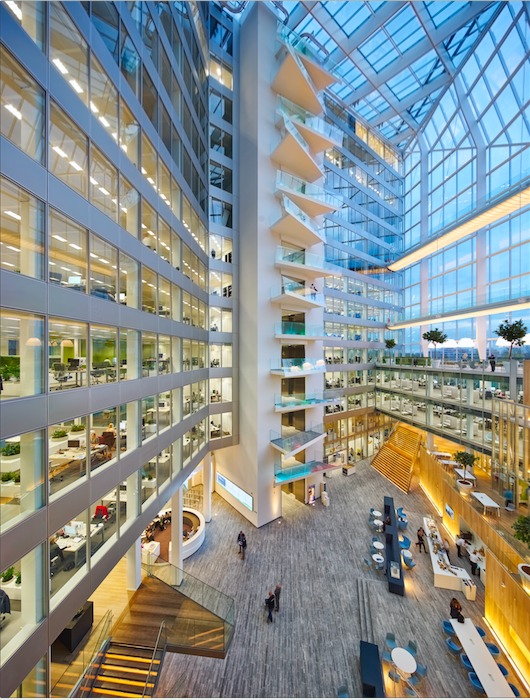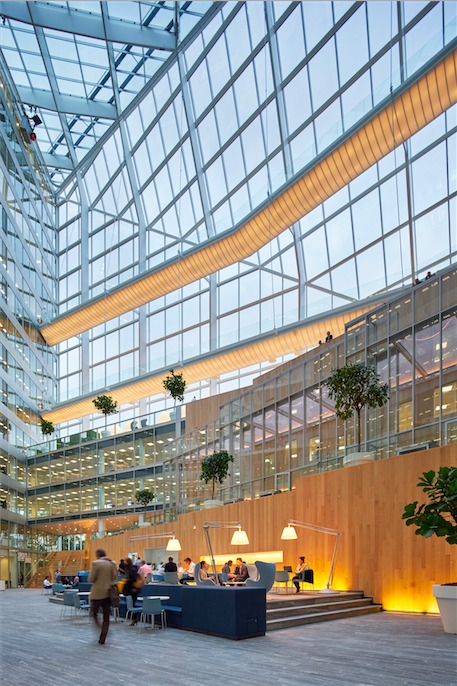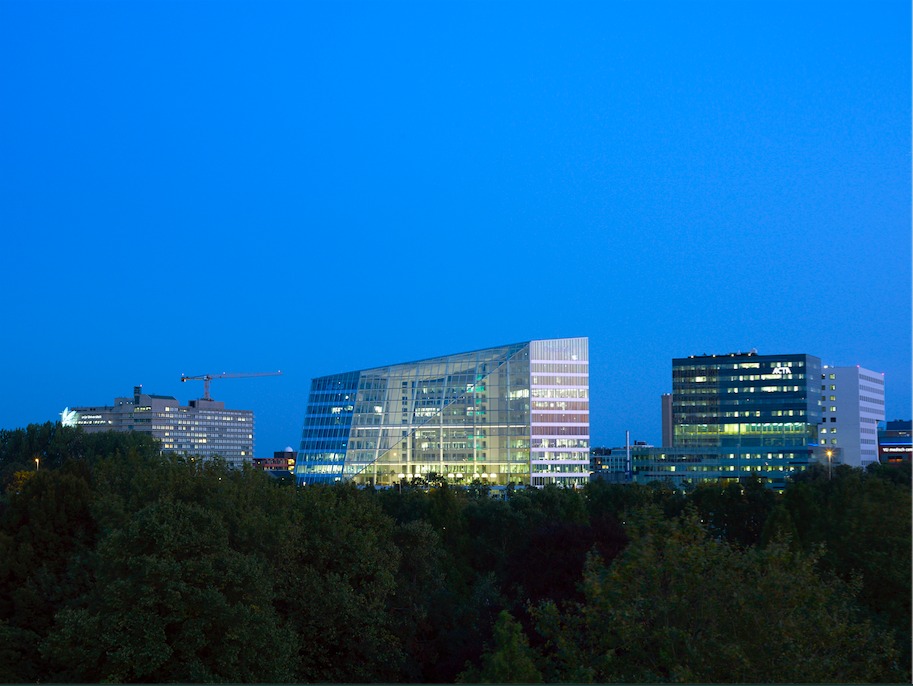In architecture, we often talk about making buildings more sustainable. You might have heard terms like ‘passive design’ and ‘regenerative design.’ My last blog post discussed these ideas. Passive design aims to reduce energy and resource use, like a building holding its breath. Regenerative design, however, is about buildings actively giving back to nature, like breathing out clean air and water. How can a building do this? Technology holds the key.
The Limits of Passive Design
Passive design is a very important first step in sustainable architecture. It focuses on using natural elements to make buildings comfortable and efficient. Think about big windows that let in sunlight for warmth in winter, or clever designs that allow cool breezes to flow through a building in summer. These ideas help reduce the need for air conditioning and heating, saving energy and money. For example, the Bullitt Center in Seattle, often called the ‘greenest commercial building in the world,’ uses features like automated windows for natural ventilation and a smart building shell to be energy net-positive [1].
While passive design reduces a building’s negative impact, it doesn’t actively improve the environment. It minimizes harm, but doesn’t create positive change. It’s a crucial foundation, but we need buildings that don’t just take less, but actually give more.
The Rise of Proactive Buildings
This is where proactive, or regenerative, buildings come in. Imagine a building not just as a shelter, but as a living part of its environment. These buildings are designed to act like natural ecosystems. They aim to improve the environment around them, not just reduce their own impact. This means they can generate more energy than they use, clean the air, manage rainwater, and even help local wildlife thrive. It’s about creating a positive impact, making the world a better place just by existing.
One great example is the Omega Center for Sustainable Living in New York. It has a special wastewater treatment system that works like natural wetlands. It cleans water and creates a beautiful space for learning [2]. Another is the Khoo Teck Puat Hospital in Singapore. It has lots of greenery that cools the building and provides a healing space for patients, while also helping local nature [3]. These buildings show how architecture can actively contribute to the health of both people and the planet.
Technology as the Game-Changer
So, how do we make buildings proactive? The answer lies in smart technology. These tools help architects and designers create buildings that work with nature, not against it.
Generative Design and Artificial Intelligence (AI)
Think of generative design as a super-smart assistant for architects. Instead of drawing every line themselves, designers give the computer a set of rules and goals. For example, they might tell it: “Design a building that uses the least amount of material, gets lots of natural light, and stays cool in a tropical climate.” The computer then uses AI to explore thousands, even millions, of design options that a human could never think of. It learns what works best and suggests the most efficient and sustainable designs [4].
This is especially exciting for materials like bamboo. Bamboo is amazing – it grows fast, is strong, and can store carbon. But each bamboo stalk is unique, and its properties can change with moisture and temperature. This allows us to design buildings that truly use bamboo to its full potential, adapting to its natural variations and the tropical climate. AI helps us unlock bamboo’s ‘secret language’ to build stronger, more sustainable structures.
Smart Materials
Imagine a building that can heal itself, change its color to reflect sunlight, or even clean the air around it. This isn’t science fiction; it’s the world of smart materials. These materials can react to their environment and change their properties. For example, some windows can automatically tint themselves to block harsh sunlight, reducing the need for air conditioning. There are even materials that can absorb pollutants from the air or self-repair small cracks, making buildings last longer and require less maintenance [5]. These innovations help buildings become more adaptive and efficient, actively contributing to a healthier environment.
IoT and Sensors
Just like our bodies have senses, smart buildings have sensors. These tiny devices, connected through the Internet of Things (IoT), collect real-time information about everything from temperature and humidity to air quality and how many people are in a room. This data is like a building’s nervous system. It allows the building to understand its own performance and make adjustments automatically. For instance, if a room is empty, the lights can dim, and the air conditioning can reduce its output, saving energy. This constant monitoring and adjustment help buildings operate at peak efficiency, minimizing waste and maximizing comfort [6].
Examples of Proactive Buildings in Action
These technologies are not just ideas; they are being used in real buildings around the world, making a tangible difference:
- The California Academy of Sciences (San Francisco, USA): This building combines passive and proactive design. Its living roof provides insulation (passive) while supporting native plants and managing stormwater (proactive). It also generates its own renewable energy and educates on environmental stewardship [7].
- The Edge (Amsterdam, Netherlands): Often called the world’s most sustainable office building, The Edge uses a vast network of IoT sensors to monitor everything from temperature and light to CO2 levels and occupancy. This data allows the building to adjust its systems in real-time, optimizing energy use and creating a highly efficient and comfortable environment. It even has a smartphone app that learns user preferences, further personalizing and optimizing the workspace [8]. This is a prime example of how IoT makes a building truly proactive in its energy management.






- One Central Park (Sydney, Australia): This residential tower is famous for its vertical gardens, which are not just for show. These gardens act as a living skin, providing natural shading, improving air quality, and reducing the urban heat island effect. The building also incorporates a tri-generation plant for energy and a wastewater treatment system, demonstrating a holistic, proactive approach to urban sustainability [9]. While not explicitly stated as using generative design, the complexity and optimization of such a system often benefit from advanced computational tools.
These examples show that buildings can be more than just shelters; they can be active participants in creating a healthier planet. They demonstrate how technology, from AI-powered design to smart materials and interconnected sensors, is enabling a new era of architecture that goes beyond simply reducing harm to actively giving back to nature.
The Future is a Partnership with Nature, Powered by Technology
The journey from passive to proactive buildings is an exciting one. It represents a fundamental shift in how we think about our built environment. No longer are buildings just static structures; they are becoming dynamic, intelligent entities that can adapt, learn, and contribute positively to the world around them.
This shift is driven by the incredible advancements in technology. Generative design, AI, smart materials, and IoT sensors are not just tools; they are enablers that allow us to design and construct buildings that are deeply integrated with natural systems. They help us understand complex environmental data, optimize material use, and create structures that are resilient and responsive to changing conditions.
Ultimately, the goal is to create a future where every building is a partner with nature. A future where our cities are not just concrete jungles, but thriving ecosystems where human life and natural life coexist and flourish. This vision is becoming a reality, one smart, proactive building at a time. It’s a hopeful vision for architecture, where innovation and sustainability go hand in hand to build a better world for everyone.
References
[1] Aulia Muflih Nasution. (2025, June 26). Passive vs Regenerative Design in Architecture: Practical Insights for Sustainable Building. Retrieved from https://auliamuflih.blog.uma.ac.id/2025/06/26/passive-vs-regenerative-design-in-architecture-practical-insights-for-sustainable-building/
[2] Omega Institute. (n.d.). Omega Center for Sustainable Living. Retrieved from https://www.eomega.org/omega-center-for-sustainable-living
[3] Khoo Teck Puat Hospital. (n.d.). Our Green Hospital. Retrieved from https://www.ktph.com.sg/about-us/our-green-hospital/
[4] Maket.ai. (n.d.). The Role of AI in Sustainable Architecture: How Generative Design is Helping to Reduce Carbon Footprints. Retrieved from https://www.maket.ai/post/the-role-of-ai-in-sustainable-architecture-how-generative-design-is-helping-to-reduce-carbon-footprints
[5] ArchDaily. (2022, May 31). What Are the Smart Materials in Architecture?. Retrieved from https://www.archdaily.com/982583/what-are-the-smart-materials-in-architecture
[6] Neuroject. (2024, September 5). IoT Sensors in Smart Buildings: Enhancing Efficiency. Retrieved from https://neuroject.com/iot-sensors-in-smart-buildings/
[7] California Academy of Sciences. (n.d.). Architecture. Retrieved from https://www.calacademy.org/academy/architecture
[8] PLP Architecture. (n.d.). The Edge. Retrieved from https://plparchitecture.com/work/the-edge/
[9] One Central Park. (n.d.). About. Retrieved from https://www.onecentralpark.com.au/about/
